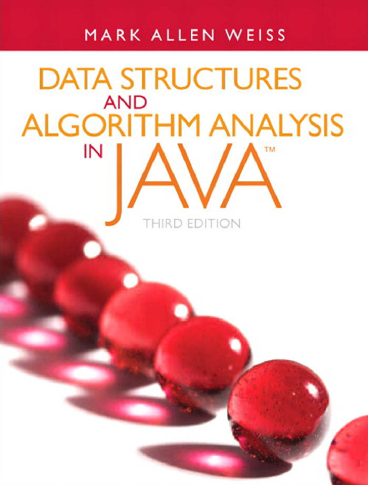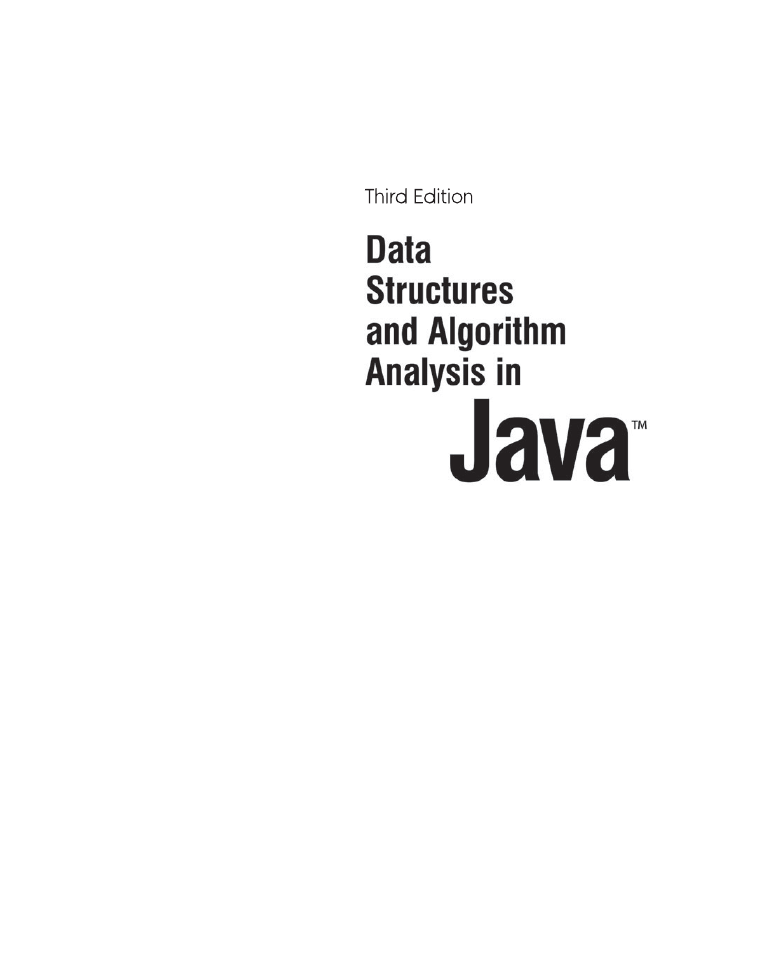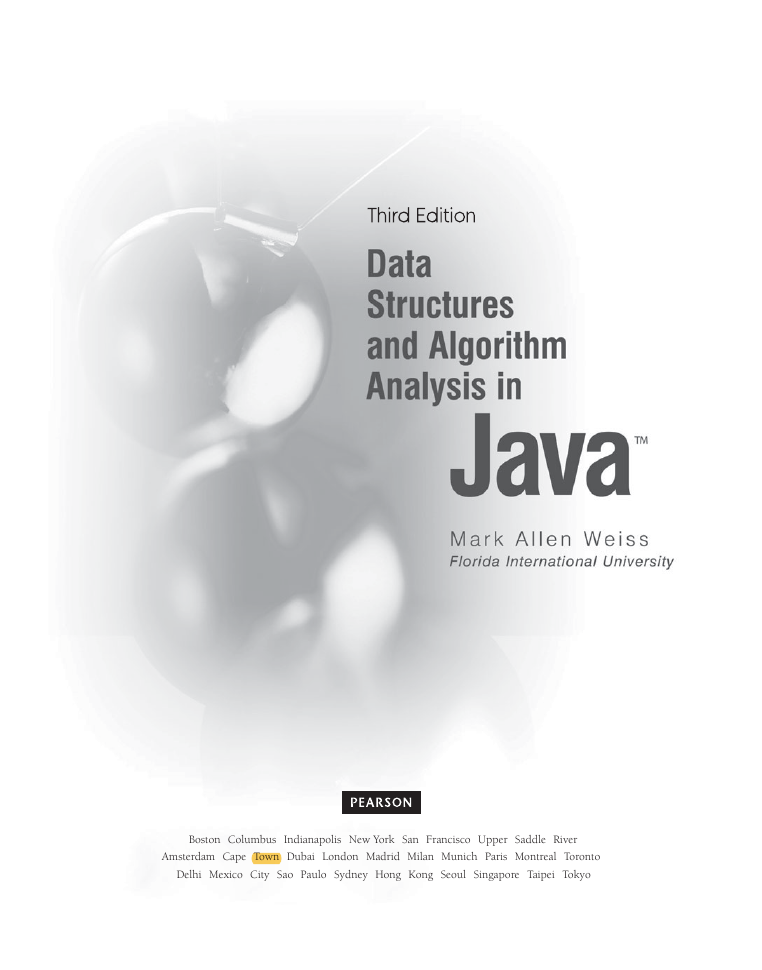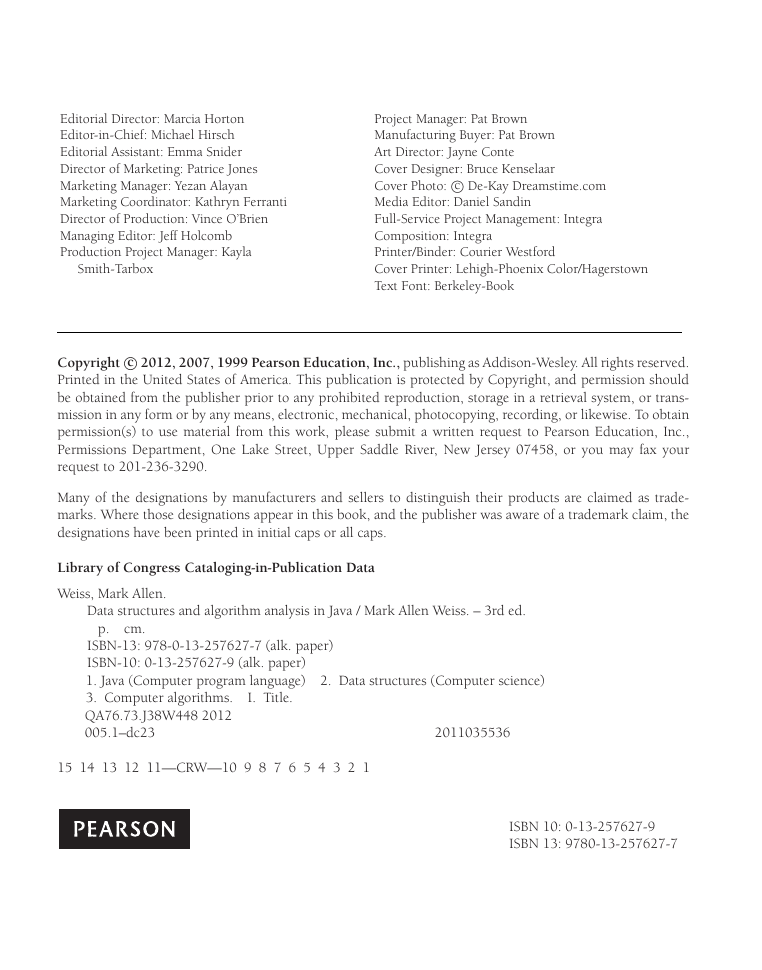Cover
Title Page
Copyright Page
Contents
Preface
Acknowledgments
Chapter 1 Introduction
1.1 What’s the Book About?
1.2 Mathematics Review
1.2.1 Exponents
1.2.2 Logarithms
1.2.3 Series
1.2.4 Modular Arithmetic
1.2.5 The P Word
1.3 A Brief Introduction to Recursion
1.4 Implementing Generic Components Pre-Java 5
1.4.1 Using Object for Genericity
1.4.2 Wrappers for Primitive Types
1.4.3 Using Interface Types for Genericity
1.4.4 Compatibility of Array Types
1.5 Implementing Generic Components Using Java 5 Generics
1.5.1 Simple Generic Classes and Interfaces
1.5.2 Autoboxing/Unboxing
1.5.3 The Diamond Operator
1.5.4 Wildcards with Bounds
1.5.5 Generic Static Methods
1.5.6 Type Bounds
1.5.7 Type Erasure
1.5.8 Restrictions on Generics
1.6 Function Objects
Summary
Exercises
References
Chapter 2 Algorithm Analysis
2.1 Mathematical Background
2.2 Model
2.3 What to Analyze
2.4 Running Time Calculations
2.4.1 A Simple Example
2.4.2 General Rules
2.4.3 Solutions for the Maximum Subsequence Sum Problem
2.4.4 Logarithms in the Running Time
2.4.5 A Grain of Salt
Summary
Exercises
References
Chapter 3 Lists, Stacks, and Queues
3.1 Abstract Data Types (ADTs)
3.2 The List ADT
3.2.1 Simple Array Implementation of Lists
3.2.2 Simple Linked Lists
3.3 Lists in the Java Collections API
3.3.1 Collection Interface
3.3.2 Iterators
3.3.3 The List Interface, ArrayList, and LinkedList
3.3.4 Example: Using remove on a LinkedList
3.3.5 ListIterators
3.4 Implementation of ArrayList
3.4.1 The Basic Class
3.4.2 The Iterator and Java Nested and Inner Classes
3.5 Implementation of LinkedList
3.6 The Stack ADT
3.6.1 Stack Model
3.6.2 Implementation of Stacks
3.6.3 Applications
3.7 The Queue ADT
3.7.1 Queue Model
3.7.2 Array Implementation of Queues
3.7.3 Applications of Queues
Summary
Exercises
Chapter 4 Trees
4.1 Preliminaries
4.1.1 Implementation of Trees
4.1.2 Tree Traversals with an Application
4.2 Binary Trees
4.2.1 Implementation
4.2.2 An Example: Expression Trees
4.3 The Search Tree ADT—Binary Search Trees
4.3.1 contains
4.3.2 findMin and findMax
4.3.3 insert
4.3.4 remove
4.3.5 Average-Case Analysis
4.4 AVL Trees
4.4.1 Single Rotation
4.4.2 Double Rotation
4.5 Splay Trees
4.5.1 A Simple Idea (That Does Not Work)
4.5.2 Splaying
4.6 Tree Traversals (Revisited)
4.7 B-Trees
4.8 Sets and Maps in the Standard Library
4.8.1 Sets
4.8.2 Maps
4.8.3 Implementation of TreeSet and TreeMap
4.8.4 An Example That Uses Several Maps
Summary
Exercises
References
Chapter 5 Hashing
5.1 General Idea
5.2 Hash Function
5.3 Separate Chaining
5.4 Hash Tables Without Linked Lists
5.4.1 Linear Probing
5.4.2 Quadratic Probing
5.4.3 Double Hashing
5.5 Rehashing
5.6 Hash Tables in the Standard Library
5.7 Hash Tables with Worst-Case O(1) Access
5.7.1 Perfect Hashing
5.7.2 Cuckoo Hashing
5.7.3 Hopscotch Hashing
5.8 Universal Hashing
5.9 Extendible Hashing
Summary
Exercises
References
Chapter 6 Priority Queues (Heaps)
6.1 Model
6.2 Simple Implementations
6.3 Binary Heap
6.3.1 Structure Property
6.3.2 Heap-Order Property
6.3.3 Basic Heap Operations
6.3.4 Other Heap Operations
6.4 Applications of Priority Queues
6.4.1 The Selection Problem
6.4.2 Event Simulation
6.5 d-Heaps
6.6 Leftist Heaps
6.6.1 Leftist Heap Property
6.6.2 Leftist Heap Operations
6.7 Skew Heaps
6.8 Binomial Queues
6.8.1 Binomial Queue Structure
6.8.2 Binomial Queue Operations
6.8.3 Implementation of Binomial Queues
6.9 Priority Queues in the Standard Library
Summary
Exercises
References
Chapter 7 Sorting
7.1 Preliminaries
7.2 Insertion Sort
7.2.1 The Algorithm
7.2.2 Analysis of Insertion Sort
7.3 A Lower Bound for Simple Sorting Algorithms
7.4 Shellsort
7.4.1 Worst-Case Analysis of Shellsort
7.5 Heapsort
7.5.1 Analysis of Heapsort
7.6 Mergesort
7.6.1 Analysis of Mergesort
7.7 Quicksort
7.7.1 Picking the Pivot
7.7.2 Partitioning Strategy
7.7.3 Small Arrays
7.7.4 Actual Quicksort Routines
7.7.5 Analysis of Quicksort
7.7.6 A Linear-Expected-Time Algorithm for Selection
7.8 A General Lower Bound for Sorting
7.8.1 Decision Trees
7.9 Decision-Tree Lower Bounds for Selection Problems
7.10 Adversary Lower Bounds
7.11 Linear-Time Sorts: Bucket Sort and Radix Sort
7.12 External Sorting
7.12.1 Why We Need New Algorithms
7.12.2 Model for External Sorting
7.12.3 The Simple Algorithm
7.12.4 Multiway Merge
7.12.5 Polyphase Merge
7.12.6 Replacement Selection
Summary
Exercises
References
Chapter 8 The Disjoint Set Class
8.1 Equivalence Relations
8.2 The Dynamic Equivalence Problem
8.3 Basic Data Structure
8.4 Smart Union Algorithms
8.5 Path Compression
8.6 Worst Case for Union-by-Rank and Path Compression
8.6.1 Slowly Growing Functions
8.6.2 An Analysis By Recursive Decomposition
8.6.3 An O( M log * N ) Bound
8.6.4 An O( M α (M, N) ) Bound
8.7 An Application
Summary
Exercises
References
Chapter 9 Graph Algorithms
9.1 Definitions
9.1.1 Representation of Graphs
9.2 Topological Sort
9.3 Shortest-Path Algorithms
9.3.1 Unweighted Shortest Paths
9.3.2 Dijkstra’s Algorithm
9.3.3 Graphs with Negative Edge Costs
9.3.4 Acyclic Graphs
9.3.5 All-Pairs Shortest Path
9.3.6 Shortest-Path Example
9.4 Network Flow Problems
9.4.1 A Simple Maximum-Flow Algorithm
9.5 Minimum Spanning Tree
9.5.1 Prim’s Algorithm
9.5.2 Kruskal’s Algorithm
9.6 Applications of Depth-First Search
9.6.1 Undirected Graphs
9.6.2 Biconnectivity
9.6.3 Euler Circuits
9.6.4 Directed Graphs
9.6.5 Finding Strong Components
9.7 Introduction to NP-Completeness
9.7.1 Easy vs. Hard
9.7.2 The Class NP
9.7.3 NP-Complete Problems
Summary
Exercises
References
Chapter 10 Algorithm Design Techniques
10.1 Greedy Algorithms
10.1.1 A Simple Scheduling Problem
10.1.2 Huffman Codes
10.1.3 Approximate Bin Packing
10.2 Divide and Conquer
10.2.1 Running Time of Divide-and-Conquer Algorithms
10.2.2 Closest-Points Problem
10.2.3 The Selection Problem
10.2.4 Theoretical Improvements for Arithmetic Problems
10.3 Dynamic Programming
10.3.1 Using a Table Instead of Recursion
10.3.2 Ordering Matrix Multiplications
10.3.3 Optimal Binary Search Tree
10.3.4 All-Pairs Shortest Path
10.4 Randomized Algorithms
10.4.1 Random Number Generators
10.4.2 Skip Lists
10.4.3 Primality Testing
10.5 Backtracking Algorithms
10.5.1 The Turnpike Reconstruction Problem
10.5.2 Games
Summary
Exercises
References
Chapter 11 Amortized Analysis
11.1 An Unrelated Puzzle
11.2 Binomial Queues
11.3 Skew Heaps
11.4 Fibonacci Heaps
11.4.1 Cutting Nodes in Leftist Heaps
11.4.2 Lazy Merging for Binomial Queues
11.4.3 The Fibonacci Heap Operations
11.4.4 Proof of the Time Bound
11.5 Splay Trees
Summary
Exercises
References
Chapter 12 Advanced Data Structures and Implementation
12.1 Top-Down Splay Trees
12.2 Red-Black Trees
12.2.1 Bottom-Up Insertion
12.2.2 Top-Down Red-Black Trees
12.2.3 Top-Down Deletion
12.3 Treaps
12.4 Suffix Arrays and Suffix Trees
12.4.1 Suffix Arrays
12.4.2 Suffix Trees
12.4.3 Linear-Time Construction of Suffix Arrays and Suffix Trees
12.5 k-d Trees
12.6 Pairing Heaps
Summary
Exercises
References
Index
A
B
C
D
E
F
G
H
I
J
K
L
M
N
O
P
Q
R
S
T
U
V
W
X
Y
Z
















 2023年江西萍乡中考道德与法治真题及答案.doc
2023年江西萍乡中考道德与法治真题及答案.doc 2012年重庆南川中考生物真题及答案.doc
2012年重庆南川中考生物真题及答案.doc 2013年江西师范大学地理学综合及文艺理论基础考研真题.doc
2013年江西师范大学地理学综合及文艺理论基础考研真题.doc 2020年四川甘孜小升初语文真题及答案I卷.doc
2020年四川甘孜小升初语文真题及答案I卷.doc 2020年注册岩土工程师专业基础考试真题及答案.doc
2020年注册岩土工程师专业基础考试真题及答案.doc 2023-2024学年福建省厦门市九年级上学期数学月考试题及答案.doc
2023-2024学年福建省厦门市九年级上学期数学月考试题及答案.doc 2021-2022学年辽宁省沈阳市大东区九年级上学期语文期末试题及答案.doc
2021-2022学年辽宁省沈阳市大东区九年级上学期语文期末试题及答案.doc 2022-2023学年北京东城区初三第一学期物理期末试卷及答案.doc
2022-2023学年北京东城区初三第一学期物理期末试卷及答案.doc 2018上半年江西教师资格初中地理学科知识与教学能力真题及答案.doc
2018上半年江西教师资格初中地理学科知识与教学能力真题及答案.doc 2012年河北国家公务员申论考试真题及答案-省级.doc
2012年河北国家公务员申论考试真题及答案-省级.doc 2020-2021学年江苏省扬州市江都区邵樊片九年级上学期数学第一次质量检测试题及答案.doc
2020-2021学年江苏省扬州市江都区邵樊片九年级上学期数学第一次质量检测试题及答案.doc 2022下半年黑龙江教师资格证中学综合素质真题及答案.doc
2022下半年黑龙江教师资格证中学综合素质真题及答案.doc